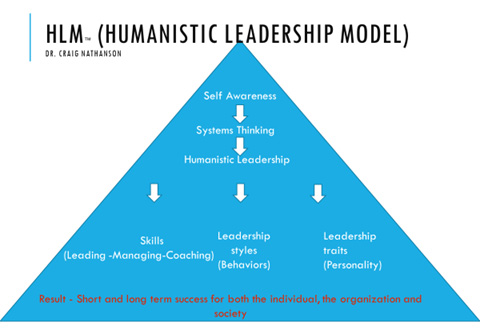The Humanistic Leadership Model (HLM)
Abstract
There are many definitions for different types of leadership, such as transformational or transactional, autocratic or democratic, task-oriented or service-oriented. Others define leadership as situational or just plain management. I have found most of these terms to be too limited and too narrow to cover the complex act of leading others. Consequently, I have developed a humanistic leadership model or HLM. The aim of humanistic leadership is to place people over profit to make business more sustainable. To thrive and survive, every business needs profit, but, with a humanistic leadership approach, business and people thrive. With the constant threats of environmental change and geopolitical conflict, we need humanistic leadership more than ever to enable a sustainable and more peaceful world.
The HLM Model

Humanistic Leadership Starts with Self-Awareness
To lead others well, one must be able to lead oneself first.
What does it mean to be self-aware? This is a lifelong process. To be self-aware means being able to answer the question: “Who am I?” This is a question that most people do not ask themselves. However, this is the most important question to answer. Self-aware leaders should also ask themselves: “What is most important and why?” In connection to this, understanding one’s values and which goals are aligned with these values are the key. Otherwise, people will spend most of their day on activities that have nothing to do with their most important values. A self-aware person should also reflect on one’s daily behavior to ensure that it always aligns with one’s most important values. Another attribute of self-awareness is to have a healthy perspective of oneself and others.
Become a System’s Thinker
I have observed that many self-aware leaders are also system’s thinkers. To be a system’s thinker means being able to think through one’s actions and potential outcomes. This includes understanding how your actions affect others. Being a system’s thinker means having the ability to understand that each action can result in unintended consequences that might affect many other people.
Humanistic system’s thinkers consider of the big picture.
- David Katz, founder of the Plastic Bank, has the mission for his company to reduce the amount of plastic in the ocean and poverty in the world through recycling projects.
- The Fourth King of Bhutan continues the pledge of national happiness for the people of Bhutan as the country’s gross national product. The country’s constitution shows that system’s thinking as environmental protection is a written law to ensure that 60% of the land is forested.
- The Chinese government has a national plan to move more than 250 million people from the farmlands to the big cities to enable economic growth.
- Norway has a national strategy to be carbon neutral by 2030.
Humanistic Leadership
Humanistic leadership is about trusting others, being ethical, having compassion, and participating as a collective whole. A humanistic leadership system has a clear and aligned vision, mission, values, and expected behaviors. There should be a transparent communication and collaboration versus internal competition among the system’s members. In a humanistic leadership system, the organizational culture is caring and supportive, and people feel appreciated and included. The humanistic leader understands at a deep level that the most important business indicator is the level of joy and meaning that people have in their work. When this is in place, all other indicators of business success will go up. The key tenants of humanistic leadership are placing the needs of people over profit and having empathy and respect for others.
- When the 2017 fires of Northern California hit, Airbnb offered free rooms to those without homes.
- Tony Hsieh, the visionary leader of the shoe company Zappos, stated that enabling people to find passionate work is the best route to delivering happiness to its customers.
- Squarespace, a web development company, lets its workers take as much vacation as needed, treating people as owners versus commodities. The company has an 18-week paid parental leave policy, believing that when a child is born, these are the most important times for family bonding.
- Patagonia, a clothing product company, closed the company for a day, encouraging customers not to buy their products to save global resources. The company views family, environment, and community first. One percent of all their revenues go to nonprofits.
- Quicken Loans is revitalizing Detroit by paying its workers subsidies to live there and has spent over 2 billion dollars to buy and renovate properties.
- The Container Store pays into a fund that is available for its staff when they have unexpected medical emergencies.
- The founder of TOMS shoes has restored eyesight in more than 400,000 people in 13 countries through eyewear donations and eye treatment in addition to donating 35 million shoes and safe drinking water to five countries.
- Love Your Melon, an apparel brand, supports children battling cancer by donating 50% of its profits to nonprofit partners.
All these companies have a compelling vision that focuses on positive influence on its people and society.
The Skills of Humanistic Leadership
The skills of humanistic leadership are leading, managing, and coaching. The humanistic leader should have all these skills.
Leading
Leading is about having a clear business vision and being able to explain this vision to people in a way that inspires them to come to work. Leading is selling tickets for the journey in a passionate and facilitative way.
Managing
Managing is the opposite of leading, requiring stability, structure, discipline, and consistency. However, it also takes into consideration the individual person. Managing requires consistent processes, good time management, and the transparent act of setting and measuring goals in a collaborative way.
Coaching
Coaching is about helping people on a daily basis to get them where they need to go. A strong leader is able to listen to and focus on people and their needs while enabling motivation. Coaching enables collaboration versus competition. The best coaches enable people to develop in their own ways, not rating and ranking them against others, but by treating them in unique ways and allowing for self-orientation and independence in their work.
The best way to see if there is humanistic leadership in place is to see if the followers can lead themselves.
The Behaviors of Humanistic Leaders
Humanistic leaders are aware of the behavioral style that fits them best and gets the best results from people.
Some people prefer a more autocratic style of leading; others prefer a more democratic and collaborative style. Some might utilize a more task-oriented and structured approach, while others are more comfortable leading in a service-oriented style. Some leaders just prefer to lead through their personal values and principles, while others lead in political ways, serving their interests first.
In my observations, leading others in a collaborative and democratic way tends to get the best results from people at work.
Personality Traits of Humanistic Leaders
Although personality is wired at birth and difficult to change, behavior can be changed. For example, an introverted leader can decide to be more outgoing and sociable even though it could be difficult for this person. However, the leader can modify the behavior to connect more directly with followers. In my observations, there are specific personality traits that humanistic leaders have. They have a high level of conscientiousness that enables deeper thinking, better organization, and discipline. A humanistic leader also should be open, have integrity, and make others feel appreciated and included. Finally, I have determined that having interpersonal sensitivity is important to understand others, and this becomes easier when a person is self-aware.
A Better Way
The humanistic leadership model is needed to better lead others at a personal, societal, and organizational level. Becoming a humanistic leader is not optional, but mandatory, if we aim for sustainability at all levels now and into the future.


